Water Resources: Global Health Crisis, Solutions, and Impact
VerifiedAdded on 2021/04/17
|13
|3576
|26
Report
AI Summary
This report delves into the critical relationship between water resources and global health, highlighting the current crisis and its far-reaching consequences. It explores how water scarcity, inadequate sanitation, and pollution contribute to the spread of waterborne diseases, impacting millions worldwide. The report examines the disproportionate effects on women and girls, who often bear the burden of water collection and face increased risks in unsanitary conditions. It reviews existing literature and research, including the roles of organizations like the World Health Organization (WHO) and UNICEF, in addressing these challenges. The report also discusses potential solutions, such as improved sanitation, water management strategies, and public health initiatives. It emphasizes the importance of safe and readily available water for public health, economic growth, and poverty reduction, as well as the need for global cooperation to ensure sustainable water resources and protect human health.

Running head: WATER RESOURCES
Water Resources (How water is currently affecting the world’s health and its possible
solutions)
Name of the Student:
Name of the University:
Author Note:
Water Resources (How water is currently affecting the world’s health and its possible
solutions)
Name of the Student:
Name of the University:
Author Note:
Paraphrase This Document
Need a fresh take? Get an instant paraphrase of this document with our AI Paraphraser

1WATER RESOURCES
Table of Contents
Introduction................................................................................................................................2
Literature Review.......................................................................................................................2
Possible solutions...................................................................................................................7
Conclusion..................................................................................................................................9
References................................................................................................................................10
Table of Contents
Introduction................................................................................................................................2
Literature Review.......................................................................................................................2
Possible solutions...................................................................................................................7
Conclusion..................................................................................................................................9
References................................................................................................................................10
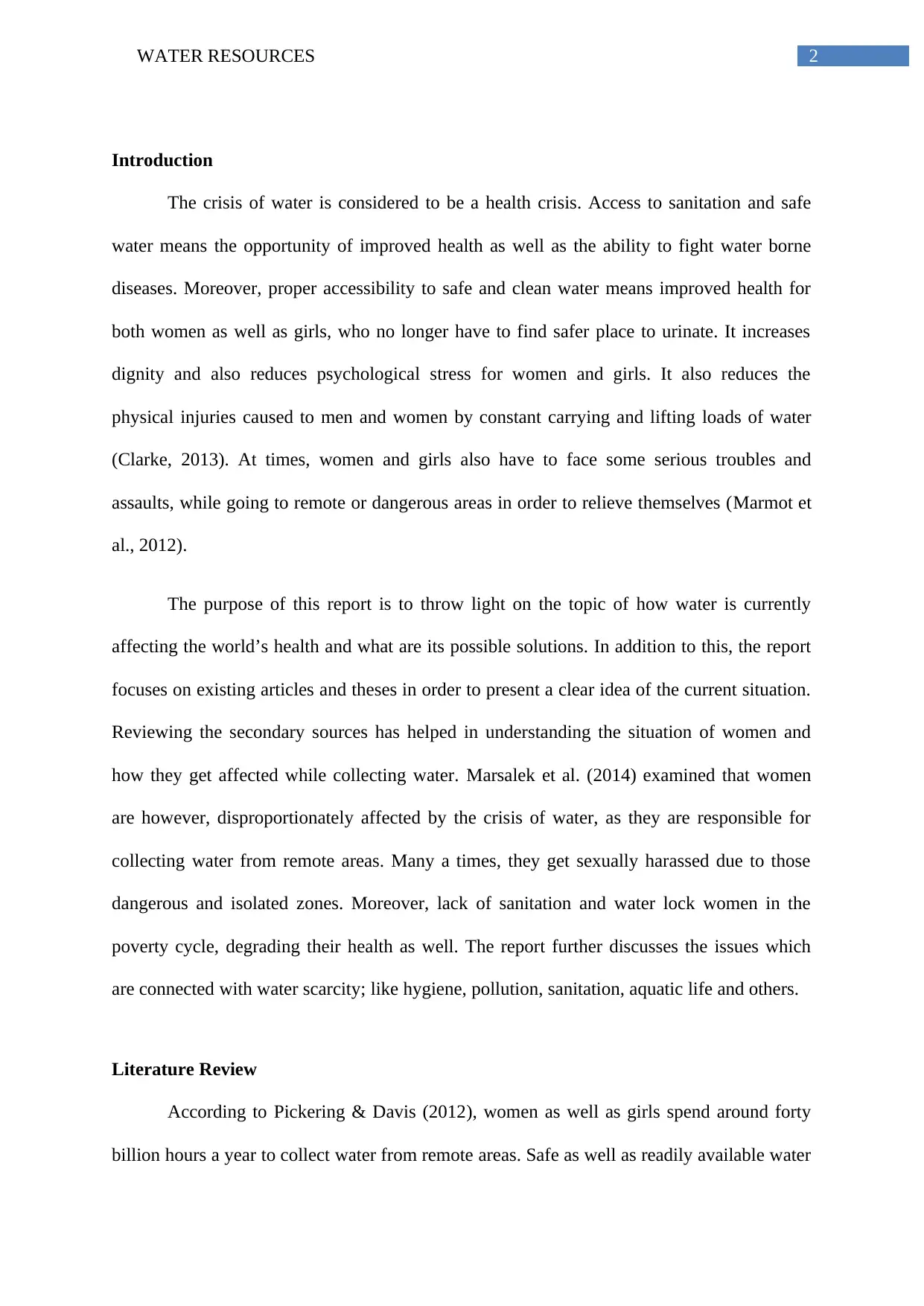
2WATER RESOURCES
Introduction
The crisis of water is considered to be a health crisis. Access to sanitation and safe
water means the opportunity of improved health as well as the ability to fight water borne
diseases. Moreover, proper accessibility to safe and clean water means improved health for
both women as well as girls, who no longer have to find safer place to urinate. It increases
dignity and also reduces psychological stress for women and girls. It also reduces the
physical injuries caused to men and women by constant carrying and lifting loads of water
(Clarke, 2013). At times, women and girls also have to face some serious troubles and
assaults, while going to remote or dangerous areas in order to relieve themselves (Marmot et
al., 2012).
The purpose of this report is to throw light on the topic of how water is currently
affecting the world’s health and what are its possible solutions. In addition to this, the report
focuses on existing articles and theses in order to present a clear idea of the current situation.
Reviewing the secondary sources has helped in understanding the situation of women and
how they get affected while collecting water. Marsalek et al. (2014) examined that women
are however, disproportionately affected by the crisis of water, as they are responsible for
collecting water from remote areas. Many a times, they get sexually harassed due to those
dangerous and isolated zones. Moreover, lack of sanitation and water lock women in the
poverty cycle, degrading their health as well. The report further discusses the issues which
are connected with water scarcity; like hygiene, pollution, sanitation, aquatic life and others.
Literature Review
According to Pickering & Davis (2012), women as well as girls spend around forty
billion hours a year to collect water from remote areas. Safe as well as readily available water
Introduction
The crisis of water is considered to be a health crisis. Access to sanitation and safe
water means the opportunity of improved health as well as the ability to fight water borne
diseases. Moreover, proper accessibility to safe and clean water means improved health for
both women as well as girls, who no longer have to find safer place to urinate. It increases
dignity and also reduces psychological stress for women and girls. It also reduces the
physical injuries caused to men and women by constant carrying and lifting loads of water
(Clarke, 2013). At times, women and girls also have to face some serious troubles and
assaults, while going to remote or dangerous areas in order to relieve themselves (Marmot et
al., 2012).
The purpose of this report is to throw light on the topic of how water is currently
affecting the world’s health and what are its possible solutions. In addition to this, the report
focuses on existing articles and theses in order to present a clear idea of the current situation.
Reviewing the secondary sources has helped in understanding the situation of women and
how they get affected while collecting water. Marsalek et al. (2014) examined that women
are however, disproportionately affected by the crisis of water, as they are responsible for
collecting water from remote areas. Many a times, they get sexually harassed due to those
dangerous and isolated zones. Moreover, lack of sanitation and water lock women in the
poverty cycle, degrading their health as well. The report further discusses the issues which
are connected with water scarcity; like hygiene, pollution, sanitation, aquatic life and others.
Literature Review
According to Pickering & Davis (2012), women as well as girls spend around forty
billion hours a year to collect water from remote areas. Safe as well as readily available water
⊘ This is a preview!⊘
Do you want full access?
Subscribe today to unlock all pages.

Trusted by 1+ million students worldwide
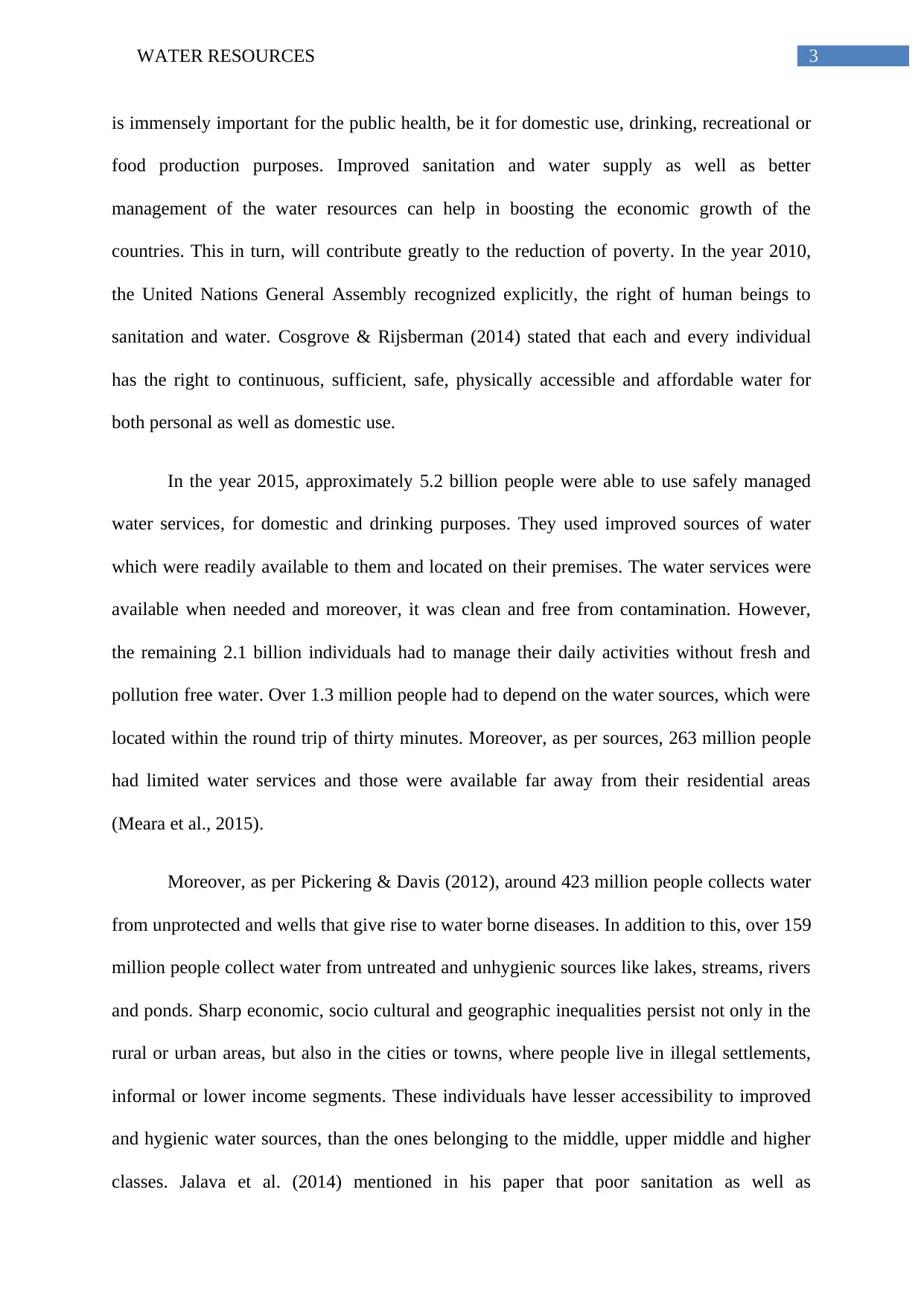
3WATER RESOURCES
is immensely important for the public health, be it for domestic use, drinking, recreational or
food production purposes. Improved sanitation and water supply as well as better
management of the water resources can help in boosting the economic growth of the
countries. This in turn, will contribute greatly to the reduction of poverty. In the year 2010,
the United Nations General Assembly recognized explicitly, the right of human beings to
sanitation and water. Cosgrove & Rijsberman (2014) stated that each and every individual
has the right to continuous, sufficient, safe, physically accessible and affordable water for
both personal as well as domestic use.
In the year 2015, approximately 5.2 billion people were able to use safely managed
water services, for domestic and drinking purposes. They used improved sources of water
which were readily available to them and located on their premises. The water services were
available when needed and moreover, it was clean and free from contamination. However,
the remaining 2.1 billion individuals had to manage their daily activities without fresh and
pollution free water. Over 1.3 million people had to depend on the water sources, which were
located within the round trip of thirty minutes. Moreover, as per sources, 263 million people
had limited water services and those were available far away from their residential areas
(Meara et al., 2015).
Moreover, as per Pickering & Davis (2012), around 423 million people collects water
from unprotected and wells that give rise to water borne diseases. In addition to this, over 159
million people collect water from untreated and unhygienic sources like lakes, streams, rivers
and ponds. Sharp economic, socio cultural and geographic inequalities persist not only in the
rural or urban areas, but also in the cities or towns, where people live in illegal settlements,
informal or lower income segments. These individuals have lesser accessibility to improved
and hygienic water sources, than the ones belonging to the middle, upper middle and higher
classes. Jalava et al. (2014) mentioned in his paper that poor sanitation as well as
is immensely important for the public health, be it for domestic use, drinking, recreational or
food production purposes. Improved sanitation and water supply as well as better
management of the water resources can help in boosting the economic growth of the
countries. This in turn, will contribute greatly to the reduction of poverty. In the year 2010,
the United Nations General Assembly recognized explicitly, the right of human beings to
sanitation and water. Cosgrove & Rijsberman (2014) stated that each and every individual
has the right to continuous, sufficient, safe, physically accessible and affordable water for
both personal as well as domestic use.
In the year 2015, approximately 5.2 billion people were able to use safely managed
water services, for domestic and drinking purposes. They used improved sources of water
which were readily available to them and located on their premises. The water services were
available when needed and moreover, it was clean and free from contamination. However,
the remaining 2.1 billion individuals had to manage their daily activities without fresh and
pollution free water. Over 1.3 million people had to depend on the water sources, which were
located within the round trip of thirty minutes. Moreover, as per sources, 263 million people
had limited water services and those were available far away from their residential areas
(Meara et al., 2015).
Moreover, as per Pickering & Davis (2012), around 423 million people collects water
from unprotected and wells that give rise to water borne diseases. In addition to this, over 159
million people collect water from untreated and unhygienic sources like lakes, streams, rivers
and ponds. Sharp economic, socio cultural and geographic inequalities persist not only in the
rural or urban areas, but also in the cities or towns, where people live in illegal settlements,
informal or lower income segments. These individuals have lesser accessibility to improved
and hygienic water sources, than the ones belonging to the middle, upper middle and higher
classes. Jalava et al. (2014) mentioned in his paper that poor sanitation as well as
Paraphrase This Document
Need a fresh take? Get an instant paraphrase of this document with our AI Paraphraser

4WATER RESOURCES
contaminated water are linked with the transmission of water borne diseases like dysentery,
diarrhea, cholera, typhoid, polio and hepatitis A.
Inappropriately managed and inadequate water as well as sanitation services expose
the individuals to fatal diseases, which has severe consequences over their health. According
to Clarke (2013), this is particularly seen in the health care facilities where both staff
members and patients are being placed with the additional risks of diseases and infection
caused due to the lack of sanitation, hygiene and water services. Globally, around 15 percent
of the patients develop infections during their stay at the hospitals, with a proportion greater
than the lower income countries. The inadequate management of the industrial, agricultural
and urban wastewater means that the drinking water of millions of individuals is chemically
polluted or dangerously contaminated.
As per Conraads et al. (2012), around 842,000 individuals are estimated to die every
year due to diarrhea, cholera, dysentery and many more diseases resulting from unsafe and
unhygienic drinking water, hand hygiene as well as poor sanitation. However, diarrhea can be
prevented at large, and also the deaths of around 360,000 young children can be avoided, if
the water related risk factors were adequately addressed to the government officials.
Moreover, where water is not adequately available, people may not consider hand washing as
a priority, after sanitation or while eating foods. Therefore, this highly leads to fatal diseases
like diarrhea, cholera and others.
However, diarrhea is considered to be the most widely known diseases which are
linked to the contaminated water and food. In addition to this, there are other water borne
diseases as well. Around 250 million people are highly affected by schistosomiasis, which is
a chronic as well as acute disease caused by the parasitic worms and their exposure to the
infested water. Moreover, Bain et al. (2013) opined that in major parts of the world, several
contaminated water are linked with the transmission of water borne diseases like dysentery,
diarrhea, cholera, typhoid, polio and hepatitis A.
Inappropriately managed and inadequate water as well as sanitation services expose
the individuals to fatal diseases, which has severe consequences over their health. According
to Clarke (2013), this is particularly seen in the health care facilities where both staff
members and patients are being placed with the additional risks of diseases and infection
caused due to the lack of sanitation, hygiene and water services. Globally, around 15 percent
of the patients develop infections during their stay at the hospitals, with a proportion greater
than the lower income countries. The inadequate management of the industrial, agricultural
and urban wastewater means that the drinking water of millions of individuals is chemically
polluted or dangerously contaminated.
As per Conraads et al. (2012), around 842,000 individuals are estimated to die every
year due to diarrhea, cholera, dysentery and many more diseases resulting from unsafe and
unhygienic drinking water, hand hygiene as well as poor sanitation. However, diarrhea can be
prevented at large, and also the deaths of around 360,000 young children can be avoided, if
the water related risk factors were adequately addressed to the government officials.
Moreover, where water is not adequately available, people may not consider hand washing as
a priority, after sanitation or while eating foods. Therefore, this highly leads to fatal diseases
like diarrhea, cholera and others.
However, diarrhea is considered to be the most widely known diseases which are
linked to the contaminated water and food. In addition to this, there are other water borne
diseases as well. Around 250 million people are highly affected by schistosomiasis, which is
a chronic as well as acute disease caused by the parasitic worms and their exposure to the
infested water. Moreover, Bain et al. (2013) opined that in major parts of the world, several

5WATER RESOURCES
harmful insects breed and live in water. They transmit and carry fatal diseases like dengue
fever and others. Such diseases have the power to take the lives of many people as well.
These insects, commonly known as vectors, instead of dirty water, prefer breeding in clean
water. As a result, the household containers of drinking water serve as their breeding
grounds.
The simple method of covering the containers of clean water with lids can reduce the
vector breeding and also reduce the contamination of household water. According to Di
Nardo et al. (2013), climate change, population growth, ever-increasing scarcity of water,
demographic changes as well as urbanization pose a great threat to the supply systems of
fresh water. By the year 2025, more than half of the world’s total population will live in the
water stressed zones. Therefore, re-use of waste water can be an important strategy for
recovering fresh nutrients in the water. The countries are increasingly using the waste water
for irrigation as well as agricultural purposes. In developing countries, this particularly
represents around 7 percent of the irrigated land. However, Garnett (2013) mentioned that if
this practice of re-using water is done in an inappropriate manner, it will pose a great health
risks.
As far as Piddock’s (2012) opinion is concerned, safely managed waste water can
help in yielding multiple benefits, which also includes increased production of food. Options
for the water sources that are used for irrigation and drinking purposes will constantly evolve,
with the ever increasing reliance on the groundwater as well as alternative sources, which
includes waste water. The climate change will further lead to the greater fluctuations in the
harvested rain water. Therefore, management of all the water resources should be improved
in order to ensure quality as well as provision. Readily and safely available water is
considered to be of high importance for the welfare of the public.
harmful insects breed and live in water. They transmit and carry fatal diseases like dengue
fever and others. Such diseases have the power to take the lives of many people as well.
These insects, commonly known as vectors, instead of dirty water, prefer breeding in clean
water. As a result, the household containers of drinking water serve as their breeding
grounds.
The simple method of covering the containers of clean water with lids can reduce the
vector breeding and also reduce the contamination of household water. According to Di
Nardo et al. (2013), climate change, population growth, ever-increasing scarcity of water,
demographic changes as well as urbanization pose a great threat to the supply systems of
fresh water. By the year 2025, more than half of the world’s total population will live in the
water stressed zones. Therefore, re-use of waste water can be an important strategy for
recovering fresh nutrients in the water. The countries are increasingly using the waste water
for irrigation as well as agricultural purposes. In developing countries, this particularly
represents around 7 percent of the irrigated land. However, Garnett (2013) mentioned that if
this practice of re-using water is done in an inappropriate manner, it will pose a great health
risks.
As far as Piddock’s (2012) opinion is concerned, safely managed waste water can
help in yielding multiple benefits, which also includes increased production of food. Options
for the water sources that are used for irrigation and drinking purposes will constantly evolve,
with the ever increasing reliance on the groundwater as well as alternative sources, which
includes waste water. The climate change will further lead to the greater fluctuations in the
harvested rain water. Therefore, management of all the water resources should be improved
in order to ensure quality as well as provision. Readily and safely available water is
considered to be of high importance for the welfare of the public.
⊘ This is a preview!⊘
Do you want full access?
Subscribe today to unlock all pages.

Trusted by 1+ million students worldwide
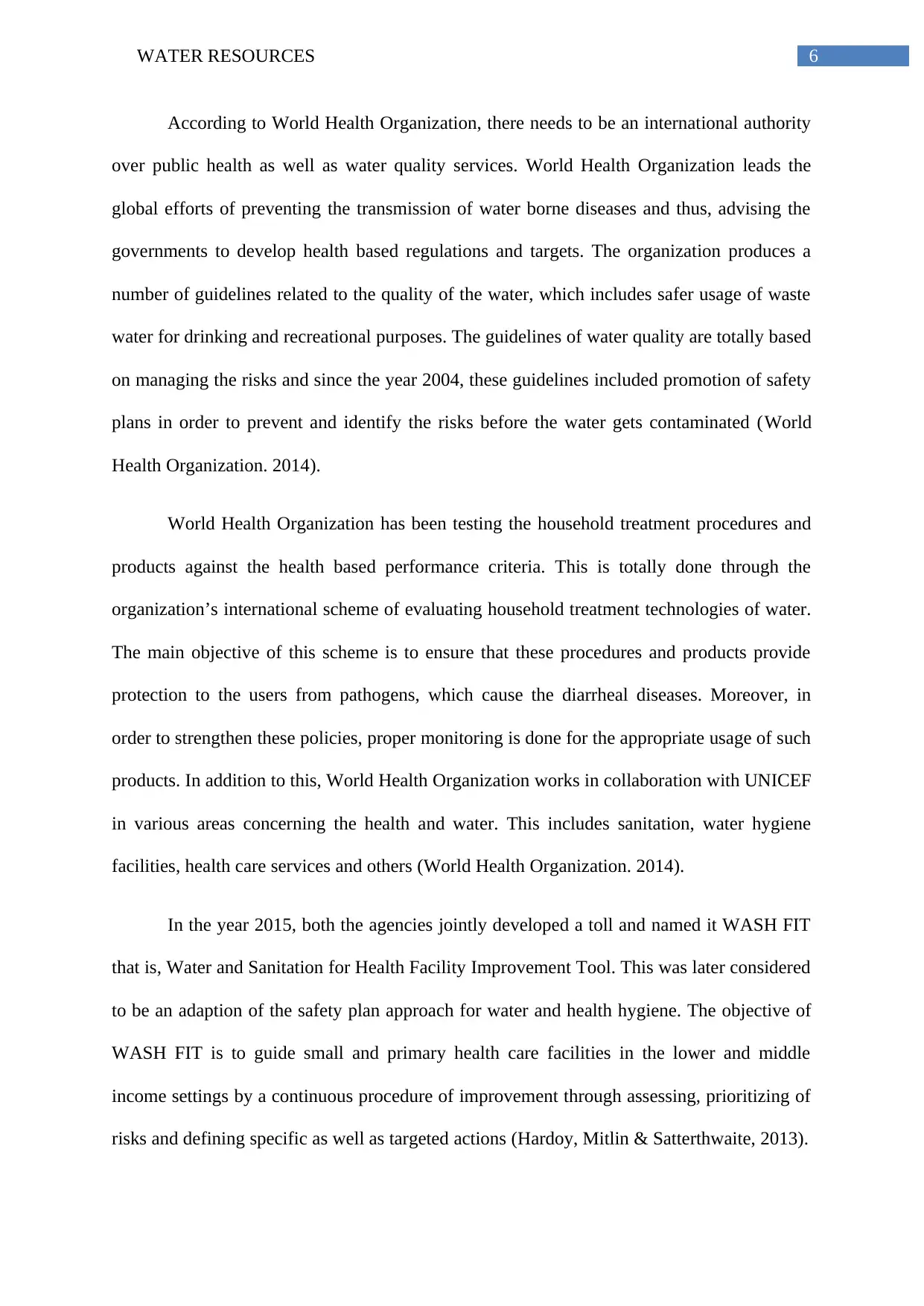
6WATER RESOURCES
According to World Health Organization, there needs to be an international authority
over public health as well as water quality services. World Health Organization leads the
global efforts of preventing the transmission of water borne diseases and thus, advising the
governments to develop health based regulations and targets. The organization produces a
number of guidelines related to the quality of the water, which includes safer usage of waste
water for drinking and recreational purposes. The guidelines of water quality are totally based
on managing the risks and since the year 2004, these guidelines included promotion of safety
plans in order to prevent and identify the risks before the water gets contaminated (World
Health Organization. 2014).
World Health Organization has been testing the household treatment procedures and
products against the health based performance criteria. This is totally done through the
organization’s international scheme of evaluating household treatment technologies of water.
The main objective of this scheme is to ensure that these procedures and products provide
protection to the users from pathogens, which cause the diarrheal diseases. Moreover, in
order to strengthen these policies, proper monitoring is done for the appropriate usage of such
products. In addition to this, World Health Organization works in collaboration with UNICEF
in various areas concerning the health and water. This includes sanitation, water hygiene
facilities, health care services and others (World Health Organization. 2014).
In the year 2015, both the agencies jointly developed a toll and named it WASH FIT
that is, Water and Sanitation for Health Facility Improvement Tool. This was later considered
to be an adaption of the safety plan approach for water and health hygiene. The objective of
WASH FIT is to guide small and primary health care facilities in the lower and middle
income settings by a continuous procedure of improvement through assessing, prioritizing of
risks and defining specific as well as targeted actions (Hardoy, Mitlin & Satterthwaite, 2013).
According to World Health Organization, there needs to be an international authority
over public health as well as water quality services. World Health Organization leads the
global efforts of preventing the transmission of water borne diseases and thus, advising the
governments to develop health based regulations and targets. The organization produces a
number of guidelines related to the quality of the water, which includes safer usage of waste
water for drinking and recreational purposes. The guidelines of water quality are totally based
on managing the risks and since the year 2004, these guidelines included promotion of safety
plans in order to prevent and identify the risks before the water gets contaminated (World
Health Organization. 2014).
World Health Organization has been testing the household treatment procedures and
products against the health based performance criteria. This is totally done through the
organization’s international scheme of evaluating household treatment technologies of water.
The main objective of this scheme is to ensure that these procedures and products provide
protection to the users from pathogens, which cause the diarrheal diseases. Moreover, in
order to strengthen these policies, proper monitoring is done for the appropriate usage of such
products. In addition to this, World Health Organization works in collaboration with UNICEF
in various areas concerning the health and water. This includes sanitation, water hygiene
facilities, health care services and others (World Health Organization. 2014).
In the year 2015, both the agencies jointly developed a toll and named it WASH FIT
that is, Water and Sanitation for Health Facility Improvement Tool. This was later considered
to be an adaption of the safety plan approach for water and health hygiene. The objective of
WASH FIT is to guide small and primary health care facilities in the lower and middle
income settings by a continuous procedure of improvement through assessing, prioritizing of
risks and defining specific as well as targeted actions (Hardoy, Mitlin & Satterthwaite, 2013).
Paraphrase This Document
Need a fresh take? Get an instant paraphrase of this document with our AI Paraphraser
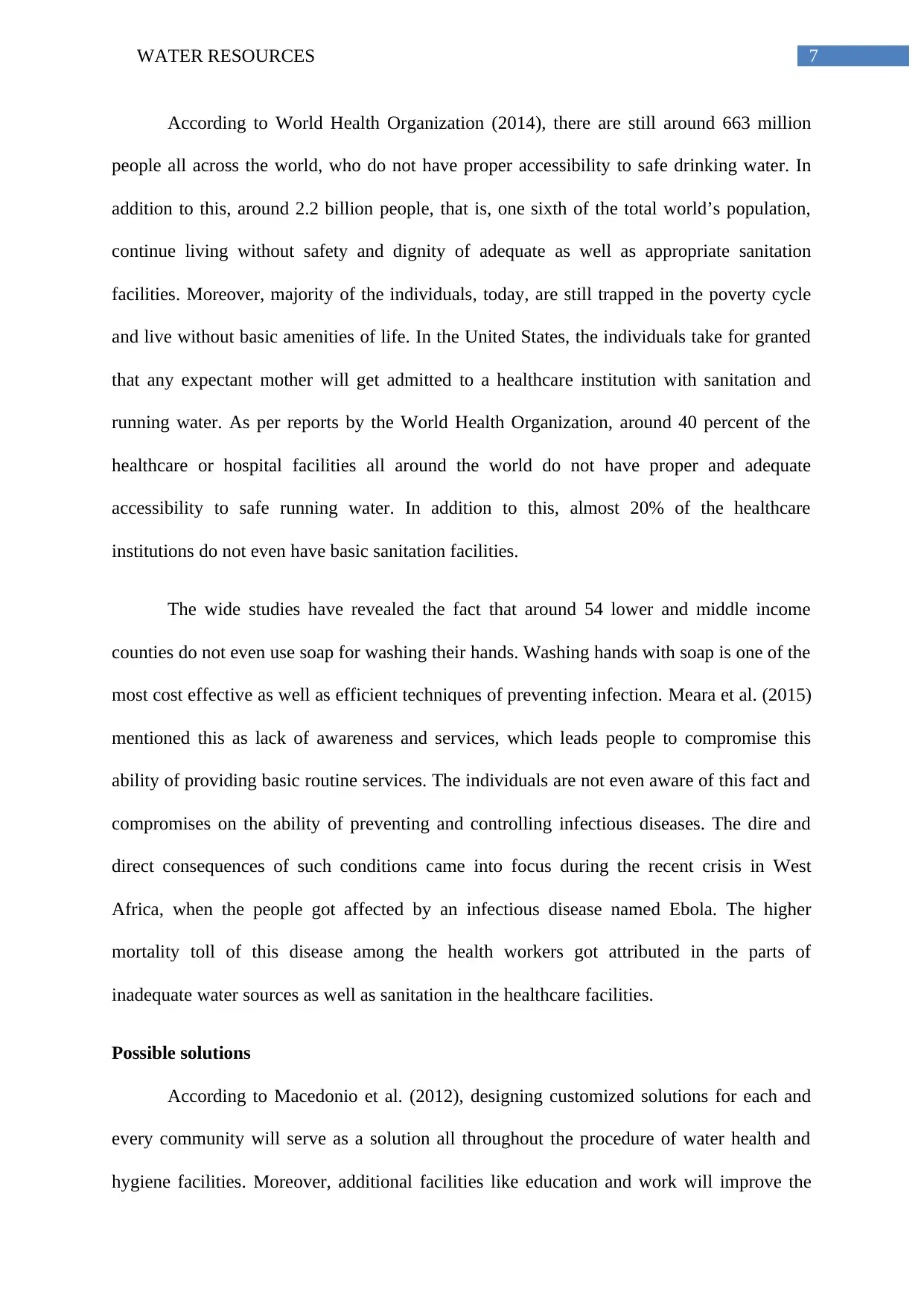
7WATER RESOURCES
According to World Health Organization (2014), there are still around 663 million
people all across the world, who do not have proper accessibility to safe drinking water. In
addition to this, around 2.2 billion people, that is, one sixth of the total world’s population,
continue living without safety and dignity of adequate as well as appropriate sanitation
facilities. Moreover, majority of the individuals, today, are still trapped in the poverty cycle
and live without basic amenities of life. In the United States, the individuals take for granted
that any expectant mother will get admitted to a healthcare institution with sanitation and
running water. As per reports by the World Health Organization, around 40 percent of the
healthcare or hospital facilities all around the world do not have proper and adequate
accessibility to safe running water. In addition to this, almost 20% of the healthcare
institutions do not even have basic sanitation facilities.
The wide studies have revealed the fact that around 54 lower and middle income
counties do not even use soap for washing their hands. Washing hands with soap is one of the
most cost effective as well as efficient techniques of preventing infection. Meara et al. (2015)
mentioned this as lack of awareness and services, which leads people to compromise this
ability of providing basic routine services. The individuals are not even aware of this fact and
compromises on the ability of preventing and controlling infectious diseases. The dire and
direct consequences of such conditions came into focus during the recent crisis in West
Africa, when the people got affected by an infectious disease named Ebola. The higher
mortality toll of this disease among the health workers got attributed in the parts of
inadequate water sources as well as sanitation in the healthcare facilities.
Possible solutions
According to Macedonio et al. (2012), designing customized solutions for each and
every community will serve as a solution all throughout the procedure of water health and
hygiene facilities. Moreover, additional facilities like education and work will improve the
According to World Health Organization (2014), there are still around 663 million
people all across the world, who do not have proper accessibility to safe drinking water. In
addition to this, around 2.2 billion people, that is, one sixth of the total world’s population,
continue living without safety and dignity of adequate as well as appropriate sanitation
facilities. Moreover, majority of the individuals, today, are still trapped in the poverty cycle
and live without basic amenities of life. In the United States, the individuals take for granted
that any expectant mother will get admitted to a healthcare institution with sanitation and
running water. As per reports by the World Health Organization, around 40 percent of the
healthcare or hospital facilities all around the world do not have proper and adequate
accessibility to safe running water. In addition to this, almost 20% of the healthcare
institutions do not even have basic sanitation facilities.
The wide studies have revealed the fact that around 54 lower and middle income
counties do not even use soap for washing their hands. Washing hands with soap is one of the
most cost effective as well as efficient techniques of preventing infection. Meara et al. (2015)
mentioned this as lack of awareness and services, which leads people to compromise this
ability of providing basic routine services. The individuals are not even aware of this fact and
compromises on the ability of preventing and controlling infectious diseases. The dire and
direct consequences of such conditions came into focus during the recent crisis in West
Africa, when the people got affected by an infectious disease named Ebola. The higher
mortality toll of this disease among the health workers got attributed in the parts of
inadequate water sources as well as sanitation in the healthcare facilities.
Possible solutions
According to Macedonio et al. (2012), designing customized solutions for each and
every community will serve as a solution all throughout the procedure of water health and
hygiene facilities. Moreover, additional facilities like education and work will improve the

8WATER RESOURCES
health of the individuals by raising awareness against water pollution. This in turn, will help
in increasing productivity for the communities as well. In addition to this, the health of the
individuals completely relies on the practice as well as awareness of sanitation, hygiene,
healthy water and washing behaviors. A huge variety of approaches must be used for
promoting hand washing through using soaps and clean sanitation facilities.
Volunteers must conduct campaigns for handing washing and induce this habit into
younger as well as older section of the society. Individuals must be trained to promote
healthy behaviors of washing hands before and after eating and sanitation. Campaigns must
be held at neighborhood villages, hospitals, healthcare institutions and schools as well. Onda,
LoBuglio & Bartram (2012) opined that awareness campaigns must be held regarding water
pollution, open defecation and other unhygienic practices. Moreover, trainings must be given
to the farmers regarding re-use of water in an appropriate manner. Clean water and basic
sanitation facilities are considered to be an essential part for the development and survival of
children as well as teenage girls. Therefore, proper care must be taken regarding this, by
raising complete awareness (Richardson & Ternes, 2014).
In addition to this, Shatat, Worall & Riffat (2013) mentioned that rapidly growing
population is decreasing the availability of water facilities. Climate change is also affecting
the water sources and causing a crisis among urban poor. In developing countries, even
millions of the city dwellers do not have regular accessibility to reliable, affordable and safe
water as well as sanitation facilities. Alderman, Turner & Tong (2012) opined that the main
reasons are poverty, lack of education and lack of awareness. The individuals are often
paying more for water from the private sources. Increasing awareness and washing facilities
in several rural areas will help in reducing the hygiene issues. Several organizations like
WHO and UNICEF are working together to eradicate this menace out of the world.
health of the individuals by raising awareness against water pollution. This in turn, will help
in increasing productivity for the communities as well. In addition to this, the health of the
individuals completely relies on the practice as well as awareness of sanitation, hygiene,
healthy water and washing behaviors. A huge variety of approaches must be used for
promoting hand washing through using soaps and clean sanitation facilities.
Volunteers must conduct campaigns for handing washing and induce this habit into
younger as well as older section of the society. Individuals must be trained to promote
healthy behaviors of washing hands before and after eating and sanitation. Campaigns must
be held at neighborhood villages, hospitals, healthcare institutions and schools as well. Onda,
LoBuglio & Bartram (2012) opined that awareness campaigns must be held regarding water
pollution, open defecation and other unhygienic practices. Moreover, trainings must be given
to the farmers regarding re-use of water in an appropriate manner. Clean water and basic
sanitation facilities are considered to be an essential part for the development and survival of
children as well as teenage girls. Therefore, proper care must be taken regarding this, by
raising complete awareness (Richardson & Ternes, 2014).
In addition to this, Shatat, Worall & Riffat (2013) mentioned that rapidly growing
population is decreasing the availability of water facilities. Climate change is also affecting
the water sources and causing a crisis among urban poor. In developing countries, even
millions of the city dwellers do not have regular accessibility to reliable, affordable and safe
water as well as sanitation facilities. Alderman, Turner & Tong (2012) opined that the main
reasons are poverty, lack of education and lack of awareness. The individuals are often
paying more for water from the private sources. Increasing awareness and washing facilities
in several rural areas will help in reducing the hygiene issues. Several organizations like
WHO and UNICEF are working together to eradicate this menace out of the world.
⊘ This is a preview!⊘
Do you want full access?
Subscribe today to unlock all pages.

Trusted by 1+ million students worldwide
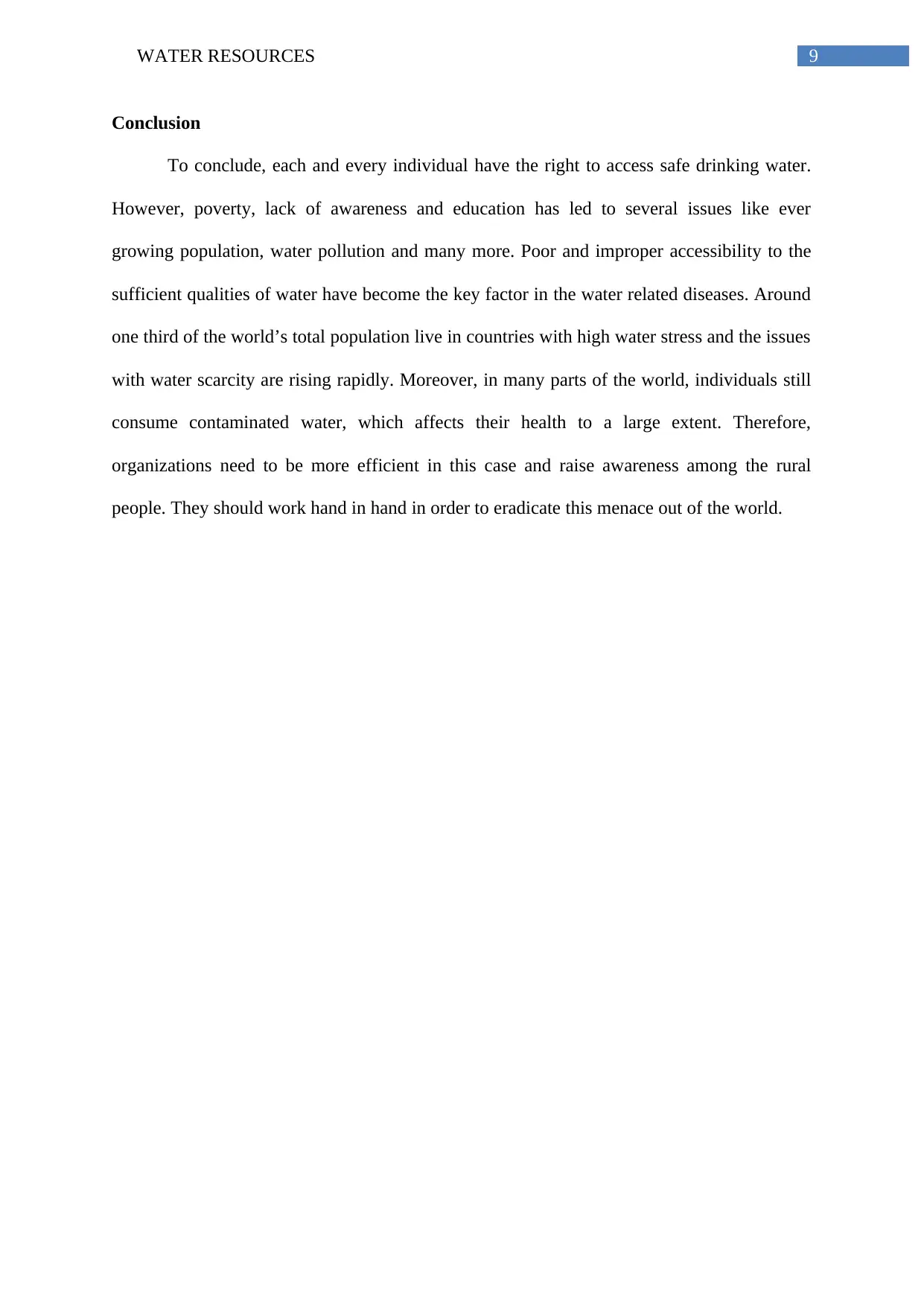
9WATER RESOURCES
Conclusion
To conclude, each and every individual have the right to access safe drinking water.
However, poverty, lack of awareness and education has led to several issues like ever
growing population, water pollution and many more. Poor and improper accessibility to the
sufficient qualities of water have become the key factor in the water related diseases. Around
one third of the world’s total population live in countries with high water stress and the issues
with water scarcity are rising rapidly. Moreover, in many parts of the world, individuals still
consume contaminated water, which affects their health to a large extent. Therefore,
organizations need to be more efficient in this case and raise awareness among the rural
people. They should work hand in hand in order to eradicate this menace out of the world.
Conclusion
To conclude, each and every individual have the right to access safe drinking water.
However, poverty, lack of awareness and education has led to several issues like ever
growing population, water pollution and many more. Poor and improper accessibility to the
sufficient qualities of water have become the key factor in the water related diseases. Around
one third of the world’s total population live in countries with high water stress and the issues
with water scarcity are rising rapidly. Moreover, in many parts of the world, individuals still
consume contaminated water, which affects their health to a large extent. Therefore,
organizations need to be more efficient in this case and raise awareness among the rural
people. They should work hand in hand in order to eradicate this menace out of the world.
Paraphrase This Document
Need a fresh take? Get an instant paraphrase of this document with our AI Paraphraser
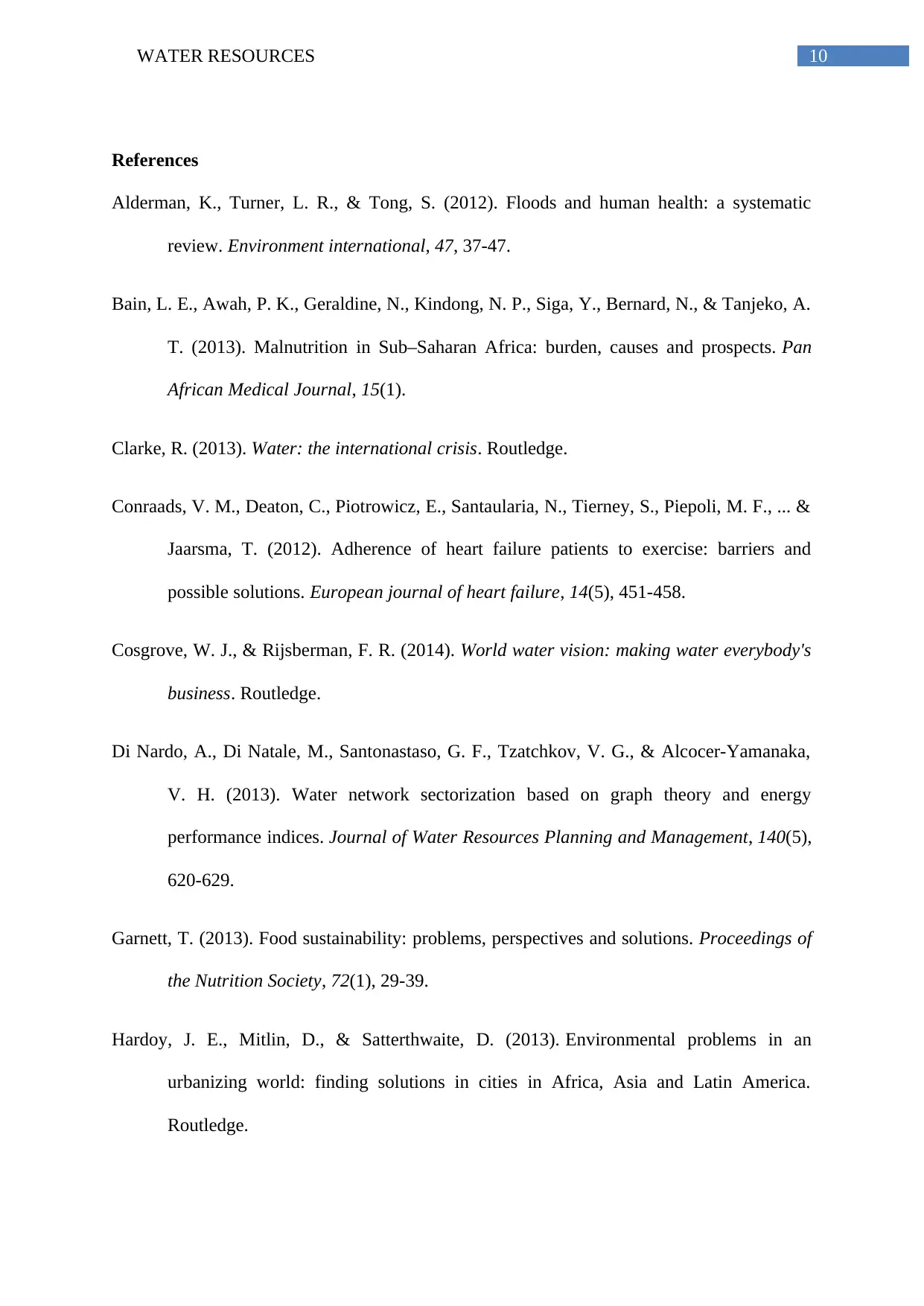
10WATER RESOURCES
References
Alderman, K., Turner, L. R., & Tong, S. (2012). Floods and human health: a systematic
review. Environment international, 47, 37-47.
Bain, L. E., Awah, P. K., Geraldine, N., Kindong, N. P., Siga, Y., Bernard, N., & Tanjeko, A.
T. (2013). Malnutrition in Sub–Saharan Africa: burden, causes and prospects. Pan
African Medical Journal, 15(1).
Clarke, R. (2013). Water: the international crisis. Routledge.
Conraads, V. M., Deaton, C., Piotrowicz, E., Santaularia, N., Tierney, S., Piepoli, M. F., ... &
Jaarsma, T. (2012). Adherence of heart failure patients to exercise: barriers and
possible solutions. European journal of heart failure, 14(5), 451-458.
Cosgrove, W. J., & Rijsberman, F. R. (2014). World water vision: making water everybody's
business. Routledge.
Di Nardo, A., Di Natale, M., Santonastaso, G. F., Tzatchkov, V. G., & Alcocer-Yamanaka,
V. H. (2013). Water network sectorization based on graph theory and energy
performance indices. Journal of Water Resources Planning and Management, 140(5),
620-629.
Garnett, T. (2013). Food sustainability: problems, perspectives and solutions. Proceedings of
the Nutrition Society, 72(1), 29-39.
Hardoy, J. E., Mitlin, D., & Satterthwaite, D. (2013). Environmental problems in an
urbanizing world: finding solutions in cities in Africa, Asia and Latin America.
Routledge.
References
Alderman, K., Turner, L. R., & Tong, S. (2012). Floods and human health: a systematic
review. Environment international, 47, 37-47.
Bain, L. E., Awah, P. K., Geraldine, N., Kindong, N. P., Siga, Y., Bernard, N., & Tanjeko, A.
T. (2013). Malnutrition in Sub–Saharan Africa: burden, causes and prospects. Pan
African Medical Journal, 15(1).
Clarke, R. (2013). Water: the international crisis. Routledge.
Conraads, V. M., Deaton, C., Piotrowicz, E., Santaularia, N., Tierney, S., Piepoli, M. F., ... &
Jaarsma, T. (2012). Adherence of heart failure patients to exercise: barriers and
possible solutions. European journal of heart failure, 14(5), 451-458.
Cosgrove, W. J., & Rijsberman, F. R. (2014). World water vision: making water everybody's
business. Routledge.
Di Nardo, A., Di Natale, M., Santonastaso, G. F., Tzatchkov, V. G., & Alcocer-Yamanaka,
V. H. (2013). Water network sectorization based on graph theory and energy
performance indices. Journal of Water Resources Planning and Management, 140(5),
620-629.
Garnett, T. (2013). Food sustainability: problems, perspectives and solutions. Proceedings of
the Nutrition Society, 72(1), 29-39.
Hardoy, J. E., Mitlin, D., & Satterthwaite, D. (2013). Environmental problems in an
urbanizing world: finding solutions in cities in Africa, Asia and Latin America.
Routledge.
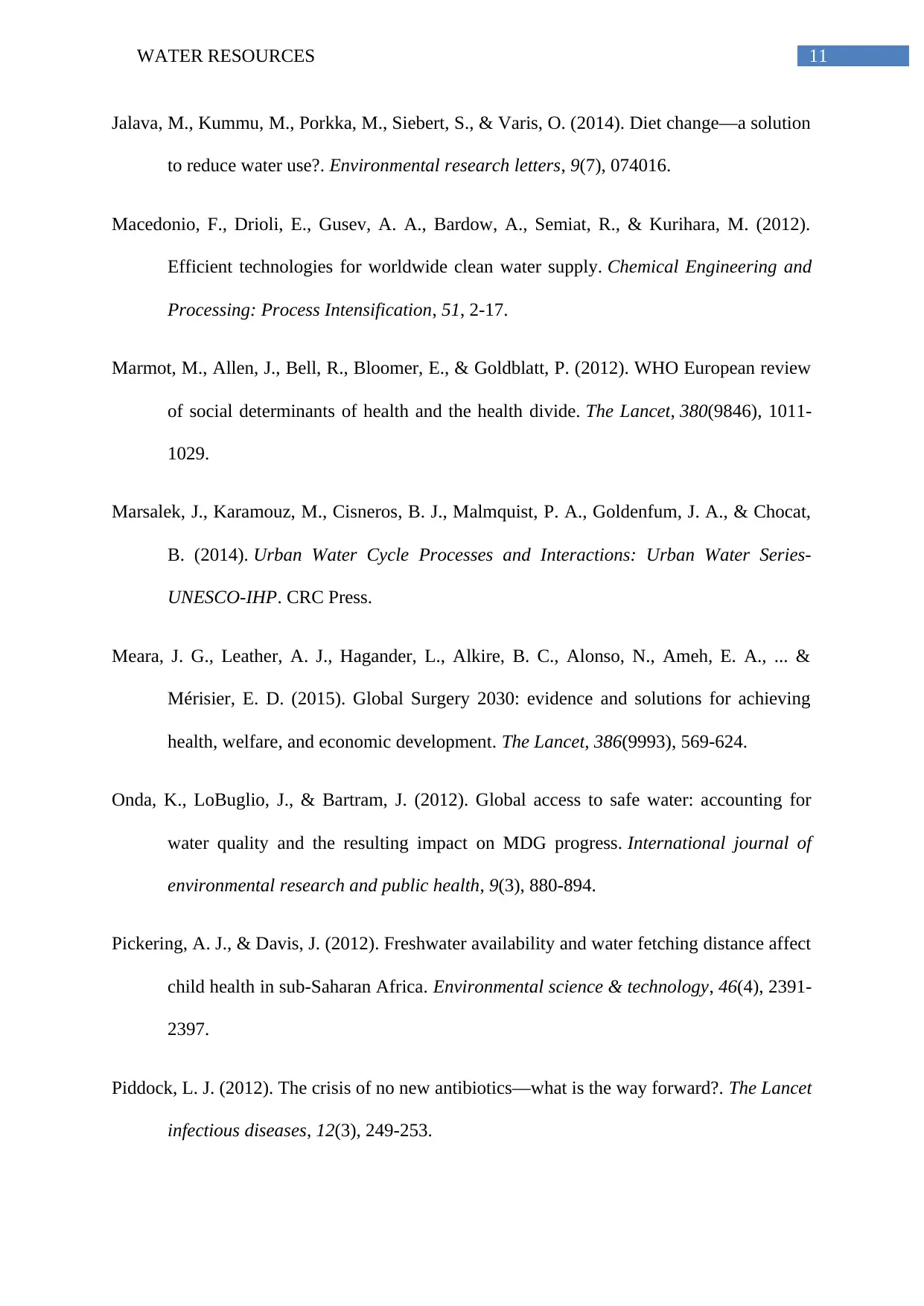
11WATER RESOURCES
Jalava, M., Kummu, M., Porkka, M., Siebert, S., & Varis, O. (2014). Diet change—a solution
to reduce water use?. Environmental research letters, 9(7), 074016.
Macedonio, F., Drioli, E., Gusev, A. A., Bardow, A., Semiat, R., & Kurihara, M. (2012).
Efficient technologies for worldwide clean water supply. Chemical Engineering and
Processing: Process Intensification, 51, 2-17.
Marmot, M., Allen, J., Bell, R., Bloomer, E., & Goldblatt, P. (2012). WHO European review
of social determinants of health and the health divide. The Lancet, 380(9846), 1011-
1029.
Marsalek, J., Karamouz, M., Cisneros, B. J., Malmquist, P. A., Goldenfum, J. A., & Chocat,
B. (2014). Urban Water Cycle Processes and Interactions: Urban Water Series-
UNESCO-IHP. CRC Press.
Meara, J. G., Leather, A. J., Hagander, L., Alkire, B. C., Alonso, N., Ameh, E. A., ... &
Mérisier, E. D. (2015). Global Surgery 2030: evidence and solutions for achieving
health, welfare, and economic development. The Lancet, 386(9993), 569-624.
Onda, K., LoBuglio, J., & Bartram, J. (2012). Global access to safe water: accounting for
water quality and the resulting impact on MDG progress. International journal of
environmental research and public health, 9(3), 880-894.
Pickering, A. J., & Davis, J. (2012). Freshwater availability and water fetching distance affect
child health in sub-Saharan Africa. Environmental science & technology, 46(4), 2391-
2397.
Piddock, L. J. (2012). The crisis of no new antibiotics—what is the way forward?. The Lancet
infectious diseases, 12(3), 249-253.
Jalava, M., Kummu, M., Porkka, M., Siebert, S., & Varis, O. (2014). Diet change—a solution
to reduce water use?. Environmental research letters, 9(7), 074016.
Macedonio, F., Drioli, E., Gusev, A. A., Bardow, A., Semiat, R., & Kurihara, M. (2012).
Efficient technologies for worldwide clean water supply. Chemical Engineering and
Processing: Process Intensification, 51, 2-17.
Marmot, M., Allen, J., Bell, R., Bloomer, E., & Goldblatt, P. (2012). WHO European review
of social determinants of health and the health divide. The Lancet, 380(9846), 1011-
1029.
Marsalek, J., Karamouz, M., Cisneros, B. J., Malmquist, P. A., Goldenfum, J. A., & Chocat,
B. (2014). Urban Water Cycle Processes and Interactions: Urban Water Series-
UNESCO-IHP. CRC Press.
Meara, J. G., Leather, A. J., Hagander, L., Alkire, B. C., Alonso, N., Ameh, E. A., ... &
Mérisier, E. D. (2015). Global Surgery 2030: evidence and solutions for achieving
health, welfare, and economic development. The Lancet, 386(9993), 569-624.
Onda, K., LoBuglio, J., & Bartram, J. (2012). Global access to safe water: accounting for
water quality and the resulting impact on MDG progress. International journal of
environmental research and public health, 9(3), 880-894.
Pickering, A. J., & Davis, J. (2012). Freshwater availability and water fetching distance affect
child health in sub-Saharan Africa. Environmental science & technology, 46(4), 2391-
2397.
Piddock, L. J. (2012). The crisis of no new antibiotics—what is the way forward?. The Lancet
infectious diseases, 12(3), 249-253.
⊘ This is a preview!⊘
Do you want full access?
Subscribe today to unlock all pages.

Trusted by 1+ million students worldwide
1 out of 13
Related Documents
Your All-in-One AI-Powered Toolkit for Academic Success.
+13062052269
info@desklib.com
Available 24*7 on WhatsApp / Email
![[object Object]](/_next/static/media/star-bottom.7253800d.svg)
Unlock your academic potential
Copyright © 2020–2025 A2Z Services. All Rights Reserved. Developed and managed by ZUCOL.




